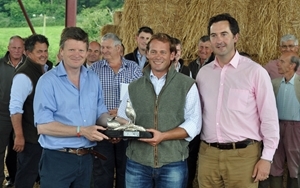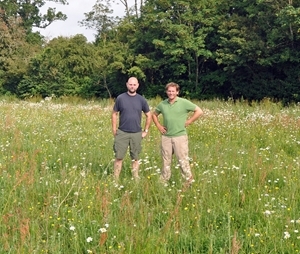 Richard Benyon, the renowned wildlife-friendly Berkshire MP, who was awarded the Game & Wildlife Conservation Trust’s prestigious 2013 Cotswold Grey Partridge Trophy for the miles of wildlife habitats that he has created for this rare bird, recently passed on the baton to the latest winner of this coveted prize.
Richard Benyon, the renowned wildlife-friendly Berkshire MP, who was awarded the Game & Wildlife Conservation Trust’s prestigious 2013 Cotswold Grey Partridge Trophy for the miles of wildlife habitats that he has created for this rare bird, recently passed on the baton to the latest winner of this coveted prize.
Mr Benyon took great delight in presenting the magnificent silver trophy to this year’s winner, John Phillips, an organic farmer from Far Hill Farm, Fairford, in  Gloucestershire. Mr Phillips is so passionate about conservation that he is devoting more than 17% of his fields to wildlife measures that help wild grey partridges and corn bunting.
Gloucestershire. Mr Phillips is so passionate about conservation that he is devoting more than 17% of his fields to wildlife measures that help wild grey partridges and corn bunting.
This prestigious conservation award is presented each year to the farm or estate that has gone that extra mile to help conserve the wild grey partridge, one of our most rapidly declining farmland birds.
Mr Phillips, who runs a 900 acre organic arable and sheep farm on part of the Fairford Estate in Gloucester, owned by the Ernest Cook Trust, was thrilled and delighted to win the GWCT’s partridge trophy. He said, “This is a huge accolade and it is also a tribute to Stephen Jones, our gamekeeper who works tirelessly to create the right year-round habitats and environments that help to support our small but increasing grey partridge population.”
The Game & Wildlife Conservation Trust has been associated with wild grey partridges for more than five decades, developing a range of techniques that help to restore this once common farmland bird, which is now locally extinct in some areas of the country. Based on its research, the GWCT also provides extensive advice to those keen to boost their partridge populations.
John Phillips, a keen partridge enthusiast, together with Stephen Jones have paid particular attention to providing the key conservation measures that are missing on intensified farming environments – namely, replacing lost habitats, providing crucial food sources throughout the year and giving protection from predators.
Currently more than 17% of the whole farm is devoted to conservation with pollen and nectar mixes, wild bird seed crops, grass margins and lapwing plots producing a riot of colour during the summer months as well as providing vital food sources for insects and other wildlife.
The GWCT’s farmland biodiversity advisor, Peter Thompson, praised Mr Phillips for his long-term commitment to grey partridge conservation and said, “John Phillips is a fantastic example to us all, and it is rare to see as much as 17% of land devoted to conservation measures that support species such as wild grey partridges and corn bunting. He also demonstrates how commercial farming can work hand in hand with conservation, and it is extremely impressive to see the important synergy that exists between farmer and gamekeeper to benefit wildlife. Their passion for this vulnerable little grey bird really shines through. ”
The Cotswold grey partridge trophy is generously sponsored by the Calmsden Estate, owned by Mark Tufnell, Chairman of the Cotswold Grey Partridge Group. Members of the Cotswold Grey Partridge Group, contribute data to the GWCT’s Partridge Count Scheme and attend regular meetings to discuss management options for supporting this native species. Members who contribute to the count scheme are also eligible to win the annual Cotswold Grey Partridge Trophy. The Cotswold Grey Partridge Group covers Gloucestershire, Herefordshire, Worcestershire, Warwickshire, Oxfordshire, Berkshire, and parts of north Wiltshire and north Somerset.
For more information on how to conserve wild grey partridges, please contact the GWCT on 01425 651013 or visit the GWCT website: www.gwct.org.uk/partridge.
END
Photocaptions: (1) Mr John Phillips (centre) from Fairford in Gloucestershire, who has gone that extra mile for wildlife on his organic farm, is pictured receiving his silver Grey Partridge Trophy from former winner of the trophy Mr Richard Benyon MP (left) and Mark Tuffnell (right) sponsor of the trophy and Chairman of the Cotswold Grey Partridge Group.
(2) Mr John Phillips (right) and his gamekeeper Stephen Jones at Far Hill Farm in Gloucestershire. More than 17% of the whole farm is devoted to conservation with pollen and nectar mixes, wild bird seed crops, grass margins and lapwing plots producing a riot of colour during the summer months as well as providing vital food sources for insects and other wildlife.
Notes to editors
The Game & Wildlife Conservation Trust (GWCT) – providing research-led conservation for a thriving countryside. The GWCT is an independent wildlife conservation charity which has carried out scientific research into Britain’s game and wildlife since the 1930s. We advise farmers and landowners on improving wildlife habitats and we lobby for agricultural and conservation policies based on science. We employ 14 post-doctoral scientists and 50 other research staff with expertise in areas such as birds, insects, mammals, farming, fish and statistics. We undertake our own research as well as projects funded by contract and grant-aid from Government and private bodies. The Trust is also responsible for a number of Government Biodiversity Action Plan species and is lead partner for grey partridge and joint lead partner for brown hare and black grouse. For Information, contact: Morag Walker – Head of Media, Telephone – direct-dial: 01425-651000. Mobile – 07736-124097 www.gwct.org.uk
Wild Grey Partridge (Perdix perdix)
Often considered an icon of Christmas, the ground-nesting wild grey partridge has suffered a huge decline over the past 40 years. Once a familiar species across the country it is now largely limited to the eastern half of the country. It particularly favours more open countryside with few trees and is most often found out on stubbles. In late winter it benefits greatly from supplementary feeding through either hoppers or by spreading grain along tracks.
- The grey partridge, Perdix perdix is the only native partridge to England. It is a classic bird of traditional arable farmland and has the highest clutch size of any English bird, laying up to twenty eggs. It has a distinctive plumage of grey, orange and brown.
- Conservation measures devised by GWCT and in operation since 1999 have brought breeding density of grey partridges back to the levels of the early 1980s from an all-time low in 2001.
- Despite bad years in 1954 and 1972, breeding success in 2012 is the worst since GWCT records began in 1933 under the Partridge Count Scheme.
- The GWCT’s Partridge Count Scheme was set up in 1933 and encourages farmers to manage and conserve grey partridges on their land, using best practice examples and providing advice based on eighty years of GWCT research. Many other farmland species benefit from this management approach.